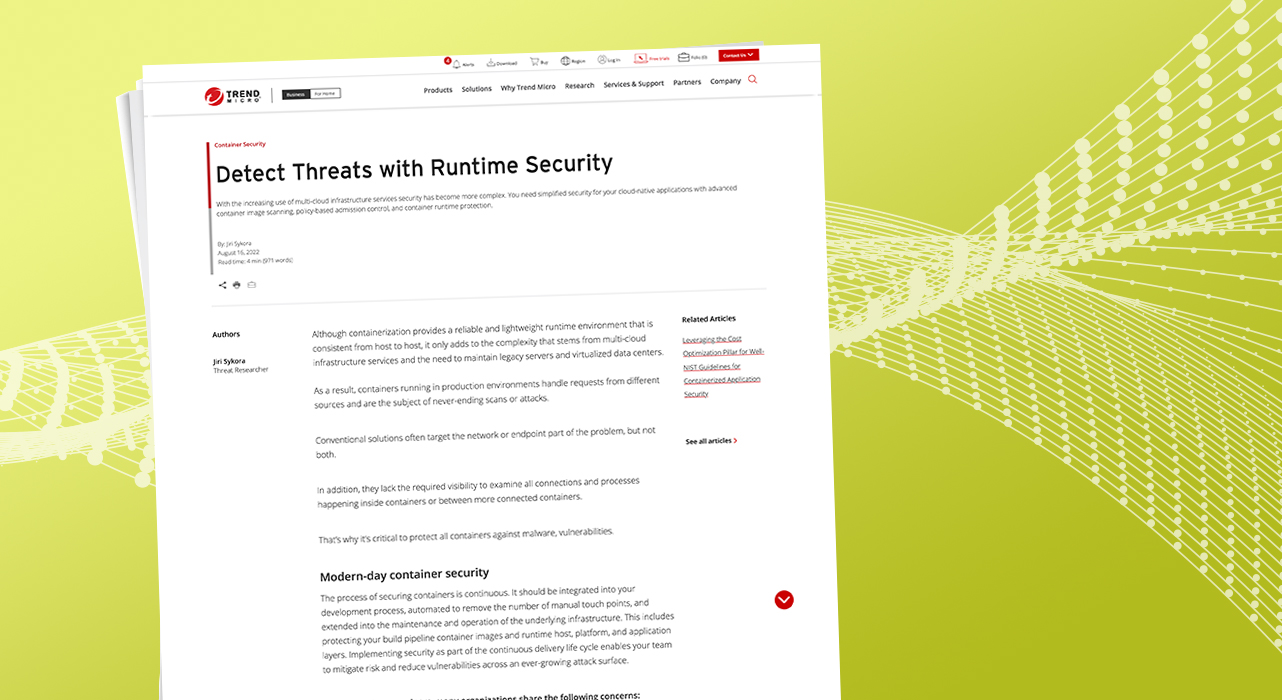- 4 PC parts I'm buying to upgrade my computer (and the 7 I'm keeping)
- 8 steps to ensure data privacy compliance across borders
- My 6 favorite open-source Android apps from the Google Play store - and why that matters
- The best anti-Prime Day deals 2025 from Best Buy, Walmart, & more: Top sales from Amazon's competition
- I've tested dozens of wearables and the Apple Watch 10 is one of my favorites - here's why
Detect Threats with Runtime Security

Although containerization provides a reliable and lightweight runtime environment that is consistent from host to host, it only adds to the complexity that stems from multi-cloud infrastructure services and the need to maintain legacy servers and virtualized data centers. This opens up a new range of security risks coming from the nature of the environment. A common example of this environment is a container running on a host with a specific network setup, and in many cases, hosted in a cloud.
As a result, containers running in production environments handle requests from different sources and are the subject of never-ending scans or attacks.
Conventional solutions often target the network or endpoint part of the problem, but not both. In addition, they lack the required visibility to examine all connections and processes happening inside containers or between more connected containers.
That’s why it’s critical to protect all containers against malware, vulnerabilities.
Modern-day container security
The process of securing containers is continuous. It should be integrated into your development process, automated to remove the number of manual touch points, and extended into the maintenance and operation of the underlying infrastructure. This includes protecting your build pipeline container images and runtime host, platform, and application layers. Implementing security as part of the continuous delivery life cycle enables your team to mitigate risk and reduce vulnerabilities across an ever-growing attack surface.
When securing containers, many organizations share the following concerns:
- The security of the container host
- Container network traffic
- The security of your application within the container
- Malicious behavior within your application
- Securing your container management stack
- The foundation layers of your application
- The integrity of your build pipeline
Trend Micro Cloud One™ – Container Security provides active defense
Runtime security provides visibility into any activity of your running containers that violates a customizable set of rules. Currently, runtime security includes a set of pre-defined rules that provide visibility into MITRE ATT&CK framework tactics for containers and container drift detection.
Trend Micro Cloud One – Container Security mitigates issues detected by the runtime visibility and control feature, based on a policy that you define. If a container violates any rule during runtime, the issue is mitigated by terminating or isolating the container based on the runtime ruleset in the policy.
As your team requires a cloud solution that can continuously deliver production-ready applications and meet the needs of the business, Container Security provides the following:
Detects security issues early, enforces admission policies, and provides assurance that only compliant containers run in production.
- Build a security policy based on container image scanning and detection of secrets, keys, malware, and vulnerabilities
- Allow images that only meet specific application or organization security policies to proceed through the pipeline
- Select from advanced policies, such as disallowing images set as privileged containers, or allow exceptions based on names or tags
- Run powerful enforcement and compliance checks, and extend Kubernetes admission control
- Get support for leading cloud service providers — Amazon Elastic Kubernetes Service (Amazon EKS), and Azure Kubernetes Service (AKS)
Uncovers vulnerabilities, malware, and sensitive data, such as API keys and passwords, within your container images, including source-code analysis powered by Snyk.
- Invoke unlimited, detailed scans with recommended fixes at any stage of your pipeline
- Minimize false positives by correlating patch layers with packages that are vulnerable in the same image
- Address vulnerabilities before they can be exploited at runtime
- Enable developers to address security bugs before deployment
Enables runtime protection for all your containerized applications.
- A software-as-a-service (SaaS) platform for cloud-native security, including host, container, and serverless container requirements
- Runtime protection deployed within the cluster, for all containerized applications within each node
- Greater visibility into attempts to run disallowed commands or illegally access files
- Runtime protection builds a model of expected behavior via Learning Mode
- Automated management tasks and policy via code, as part of a CI/CD pipeline
Pwnkit use case
Security researchers disclosed PwnKit as a memory corruption vulnerability in polkit’s pkexec, assigned with the ID CVE-2021-4034 (rated “High” at 7.8). The gap allows a low-privileged user to escalate privileges to the root of the host. Various proofs of concept (PoCs) have been disclosed, written in different languages (such as several in C, Python, Bash, and Go), and the vulnerability has been there for over 13 years, affecting all versions of the pkexec since its first distribution in 2009.

